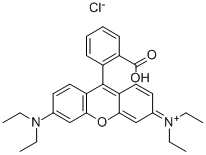| Chemical Properties | C.I. Food red 15 is a green crystalline or redviolet powdered solid |
| Chemical Properties | red/brown or green crystals |
| Uses | As a dye, especially for paper; as a reagent for antimony, bismuth, cobalt, niobium, gold, manganese, mercury, molybdenum, tantalum, thallium, tungsten; as biological stain. Provisionally listed for use in drugs and cosmetics. |
| Uses | A useful fluorochrome for histology, FRET and mitochondrial probe. |
| Uses | Rhodamine B is used in biological studies for an anti-reactive oxygen species/hepatic fibrosis drug delivery system based on salvianolic acid B loaded mesoporous silica nanoparticles. Dyes and metabolites, Environmental Testing. |
| Definition | ChEBI: An organic chloride salt having N-[9-(2-carboxyphenyl)-6-(diethylamino)-3H-xanthen-3-ylidene]-N-ethylethanaminium as the counterion. An amphoteric dye commonly used as a fluorochrome. |
| General Description | Green crystals or reddish-violet powder. Used as a dye, especially for paper, as a metal chelating reagent, and in drugs and cosmetics. |
| Air & Water Reactions | Very soluble in water. Solution is bluish-red. Dilute solutions are strongly fluorescent. |
| Reactivity Profile | Acidic organic/inorganic salts, such as Rhodamine B, are generally soluble in water. The resulting solutions contain moderate concentrations of hydrogen ions and have pH’s of less than 7.0. They react as acids to neutralize bases. These neutralizations generate heat, but less or far less than is generated by neutralization of inorganic acids, inorganic oxoacids, and carboxylic acid. They usually do not react as either oxidizing agents or reducing agents but such behavior is not impossible. Many of these compounds catalyze organic reactions. |
| Hazard | Questionable carcinogen. |
| Potential Exposure | It is used as a color additive in drugs, foods, cosmetics, and fabric dyes. It is also used as a tracing agent in water pollution studies. May be used as an agricultural chemical |
| Shipping | UN3143 Dyes, solid, toxic, n.o.s. or Dye intermediates, solid, toxic, n.o.s., Hazard Class: 6.1; Labels: 6.1-Poisonous materials, Technical Name Required. |
| Purification Methods | Major impurities are partially dealkylated compounds not removed by recrystallisation.Purify the dye by chromatography, using ethyl acetate/isopropanol/ammonia (conc)(9:7:4, RF 0.75 on Kieselgel G). It has also been crystallised from a concentrated solution in MeOH by slow addition of dry diethyl ether; or from EtOH containing a drop of conc HCl by slow addition of ten volumes of dry diethyl ether. The solid is washed with ether and air dried. The dried material has also been extracted with *benzene to remove oil-soluble material prior to recrystallisation. Store it in the dark. [Beilstein 18 II 486, 18 III/IV 8246, 19/8 V 669.] |
| Properties and Applications | TEST ITEMSSPECIFICATIONAPPEARANCEGREEN GLITTERY CRYSTALSHADE (COMPARE TO STANDARD)CLOSEWATER SOLUBILITY (60°C)8 g/L minWATER INSOLUBLE0.5% maxTINTING STRENGTH500-505 % |
| Incompatibilities | Dust may form explosive mixture with air. Incompatible with oxidizers (chlorates, nitrates, peroxides, permanganates, perchlorates, chlorine, bromine, fluorine, etc.); contact may cause fires or explosions. Keep away from alkaline materials, strong bases, strong acids, oxoacids, epoxides, strong reducing agents |
